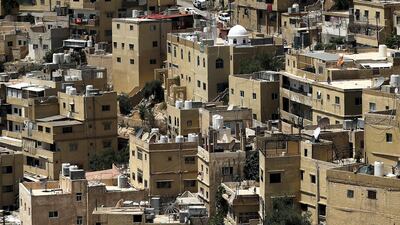Jordan’s government increased funding for impoverished families on Monday amid the coronavirus pandemic and record unemployment.
The Department of Statistics said unemployment had reached 23.9 per cent in the third quarter this year compared with 19.1 per cent in the same period last year.
The highest unemployment rate recorded since 1968 was made public as Finance Minister Mohamad Al Ississ announced the 2021 budget.
He said 38 per cent more money will be spent next year on the National Assistance Fund, which provides cash assistance to the kingdom’s poorest household.
At least 15 per cent of Jordanians lived below the official poverty line of 68 dinars ($95) per capita per month at the end of 2018.
The government-owned fund gave 50 to 200 dinars on regular bases to more than 75,000 families by the end of last year.
The amount each family receives is based on the number and ages of members in the household and their physical and material condition.
But the funds size of 145 million dinars ($203 m) before the projected increase, would still comprise only a fraction of the overall budget for 2021.
Mr Al Ississ told reporters that “one of the government’s most important priorities is to care for the vulnerable classes suffering in this difficult time”.
“We therefore initiated an unprecedented increase in the National Assistance Fund,” he said.
The 2021 budget forecasts spending of 9.9 billion dinars and a deficit of 2 billion dinars, levels roughly similar to those that the government had projected for this year.
Mr Al Ississ said high unemployment was “the main concern” of authorities.
But he made it clear that the government’s room for manoeuvre is limited because salaries account for 65 per cent of spending.
Another 17 per cent of the 2021 budget will go to pay for servicing the public debt, which is at least $37 billion.
He said these parameters constitute “hard financial reality”.
Jordan’s public debt is huge compared with the modest output of the country’s economy.
The population is 10 million and Jordan’s gross domestic product was $44 billion last year.
The government expects the economy to shrink by at least three per cent this year, citing curfews and other measures to try and contain the spread of the coronavirus as the reasons.
“A large part of the revenue drop we are suffering is linked to the closures we have been through this year,” he said.
But a two per cent growth the Jordan central bank said it registered last year was part of more than a decade-long economic stagnation accompanied by high poverty and unemployment rates.
Most of Jordan’s 219,000 coronavirus cases and 2,751 deaths were officially registered the last two months, prompting the authorities to reinstate closures and curfew measures in the last two weeks.
Mr Al Ississ expected a 2.5 per cent economic growth next year, fuelled by pent up demand for goods and services, unless the coronavirus situation takes a turn for the worse.
He said that because of the coronavirus the hardest challenge “for any financial official is the lack of clarity in reading next year’s economic and financial curves.”


